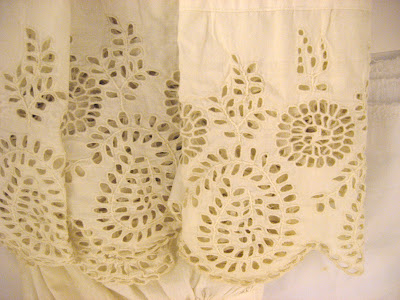
The fantasy dress maker was inspired by borderie anglaise this month.
Borderie anglaise is characterized by open spaces or eyelets in a variety of sizes and spaces, the edges of the eyelets are oversewn with buttonhole stitch. Designs are fairly simple, floral motifs, scrolls and palms or paisleys.
Here are a couple mid 1860's examples, first a petticoat:

And a pair of undersleeves:

It's origins are uncertain. According to Weldon, Broderie Anglaise originated from Czecho-Slovakian peasant embroidery and was brought to England in the 9 th century. Mary Thomas says it is also known as Ayrshire, English, Eyelet, Madeira or Swiss work, also notes the work from Czechoslovakia , though does not offer Broderie Anglaise origins. Pamela Clappburn states it is “a type of cutwork embroidery which evolved in Britain about 1850 from the earlier Ayrshire embroidery”. Certainly it became very popular at this time.
Fabrics used had a firm fine texture – cambric, muslin, cotton, lawn, fine linen, good crepe de chine.
The work consists of open worked spaces, varying in size and shape. The design is traced onto closely woven fabric. Running stitch is first worked around the traced outline of round or oval holes ( eyelets), then the shape is pierced (with a stiletto, a sharp-pointed tool) or cut from the centre. Each hole is made as work progresses. T he edges are then stitched with overcast stitch or buttonhole stitch.
In time, the holes became bigger, which meant they had to be cut out. This was done by snipping with sharp pointed scissors, from side to side and top to bottom of the shape without cutting the outline thread. The fabric flaps were turned under, then the hole over-sewn. Eyelets with less than ¼ inch diameter used a stiletto, larger than ¼ inch, are cut.
I chose a pattern from the February 1857 edition of Peterson's Magazine:

Here's my results:

The directions state: "It is cut out ans sewn over with rather coarse embroidery cotton; the best and most durable material being a fine long cloth."
I had some lovely linen in my stash for the base. I cut each eyelet as I was ready to stitch, using size 11/0 seed beads as my substitute for "coarse embroidery cotton".



I like it and am visualizing other projects where I could use the technique - maybe a bridal bag or even an Edwardian bolero style jacket.



I like it and am visualizing other projects where I could use the technique - maybe a bridal bag or even an Edwardian bolero style jacket.


Nice! Very different use of bead embroidery!
ReplyDeleteThis is wonderful.
ReplyDeleteHow beautiful!!! And such a unique way to showcase your beautiful beading!!! I love any of the 'old' designs for embroidery and this is just another one I'll have to remember. VERY nicely done!!
ReplyDeleteLuuuuuve it! Great job.
ReplyDeletelove this. you are so talented.
ReplyDeleteWow!!!! I love this! You need to have a beading workshop! I need to learn how to bead stuff! Love it!
ReplyDelete